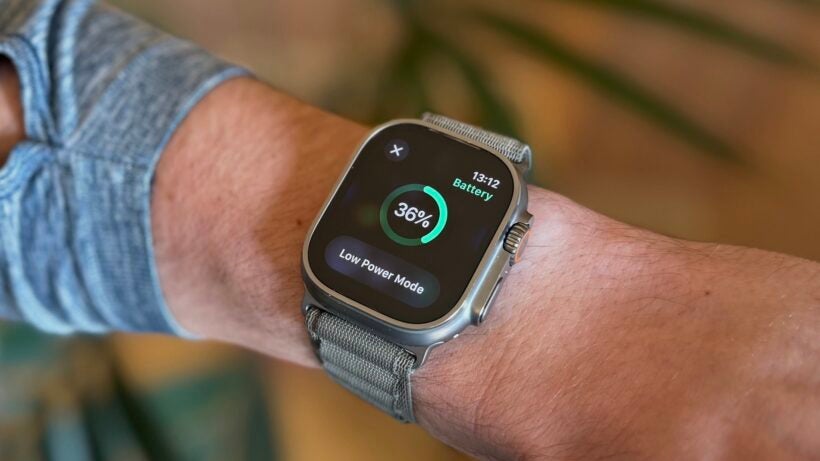Make the Apple Watch battery last longer with these quick tips.
Battery life remains the number one complaint about the Apple Watch, yet there are many ways to improve the staying power of the smartwatch.
Whether tinkering with display settings, optimizing battery efficiency during the day, or turning off some features entirely, it’s possible to double the battery life of the Apple Watch with just a few simple changes.
Below, we’ve provided 14 of our favorite ways to improve Apple Watch battery life—and these tips and tricks will prove invaluable to Series or SE owners, particularly.
The brand’s Ultra model has ended much of the battery anxiety associated with its siblings, with it able to stretch to around three days on a single charge. Yet, even owners of the most premium Apple Watch can utilize some of the tips outlined below.
Let’s learn how to maximize the battery life on your Apple Watch.
More essential reading:
- Apple Watch tips, tricks, and hidden features
- Apple Watch Series 10 review
- Apple Watch Ultra 2 review
Apple Watch battery life: FAQs
At the risk of ignoring the most obvious point concerning battery life, performance is all relative. You could log a workout that drains the battery in a flash, or you could wear the watch all day without really checking it, and it’ll last longer.
Apple states that the Series 10 (and older) and the Watch SE models are both good for 18 hours of battery life. It also states the Apple Watch Ultra 2 (and Ultra) has 36 hours of battery life.
We’ve tested every generation of the Apple Watch thoroughly, and we’ve found that newer generations of Apple Watch – the Series 5, SE, and newer – will routinely last around 30 hours between charges. And while we have seen fluctuations in testing, the Apple Watch Ultra generally lasts between 48-72 hours of normal use.
However, this is generally without the strain of long periods of GPS tracking or LTE support.
The official Apple estimate factors in 90 separate time checks, 90 notifications, 45 minutes of app use, and a 60-minute workout with music playback from the Apple Watch over Bluetooth.
In our experience, yes. Typically, we notice around a 10% dip versus not having the feature turned on, though this does depend, as ever, on things like notification settings.
This depends on which Apple Watch you own and which cable you’re using. In our experience with the Series 7-9, it takes around 70-90 minutes to reach a 0-100% charge with the Magnetic Fast-Charge USB-C cable.
The Apple Watch Series 10 has a redesigned charging coil, which will charge 80% in 30 minutes with the same fast charger as the older Series 7/8/9.
If you’re new to the Apple Watch, you’d be forgiven for not stumbling across the battery percentage during your initial play-around in the menus.
There are four ways you can view how much battery you have left on your Apple Watch:
1. Press the side button to access the Control Center and view the battery percentage.
2. Add a battery complication to your watch face.
3. On an iPhone, you can add a battery widget to show the battery percentage of a connected Apple Watch.
4. When your Apple Watch is charging in Nightstand Mode, simply hit the green charging icon to check the battery percentage.

1. Use Low Power Mode
The simplest way to prolong the Apple Watch battery is Low Power Mode. This doubles the battery life estimate from 18 hours to 36 hours (on Series 10) and up to 72 hours on Apple Watch Ultra.
It’s able to work on any Apple smartwatch running watchOS 9 or later meaning Series 4 and newer. However, there is a substantial loss of features while running Low Power Mode.
Follow these steps to turn Low Power Mode on:
1. First, make sure your Apple Watch is running watchOS 9 or later.
2. Go to the battery meter icon in the ‘Settings’ dock and toggle ‘Low Power Mode’ to on.
3. Low Power Mode will stay on until you turn it off manually or charge the Apple Watch past 80%.
2. Get over 35 hours of GPS tracking
As standard Apple says that the Ultra 2 will get 12 hours GPS tracking. But you can extend this dramatically by using Low Power Mode.
Enabling Low Power Mode for your workout will boost battery life to 17 hours of multiband GNSS tracking. Just make sure that Optimized Charge Limits aren’t hobbling your capacity (see below).
But you can go even further, although this is for hiking workouts only:
If you enable Low Power Mode during workouts, and then go to Settings > Workouts > Fewer GPS and heart rate readings, you can boost GPS workout tracking up to a massive 35 hours.
We put all these modes to the test in our Apple Watch Ultra 2 ultramarathon test, and found really impressive battery life performance – and exceeding Apple’s own estimates.
3. Check Optimized Charge Limit isn’t restricting battery life
Optimized Charge Limit tries to maximize the lifespan of your Apple Watch battery by reducing the time spent fully charged. It learns your habits, but the upshot is that your smartwatch may only charge to 80%.
- Go to Settings on your Apple Watch.
- Tap Battery.
- Tap Battery Health.
- Turn off Optimized Battery Charging.
4. Turn off the always-on display mode
This one applies to Apple Watch Series 5-10, which supports keeping the display alive at all times. It’s a great feature, but it does inevitably drain battery life.
Here’s how to control the always-on display on Apple Watch:
1. Go to ‘Settings’.
2. Tap ‘Display & Brightness.
3. Tap ‘Always On’ to toggle the feature on or off.
5. Disable Wake on Wrist Raise
The Apple Watch uses its gyroscope and accelerometer to instantly turn on the display for easy viewing whenever you raise your wrist.
Unfortunately, this means that the display will activate any time you raise your wrist, like when you’re watching a movie, raising your hand, or stretching. And each time it does, battery life inevitably takes a tiny punch.
If you’re happy to tap the screen or press a button each time you want to wake the display, here’s how to change the settings:
1. Go to ‘Settings’.
2. Tap ‘General’.
3. Select ‘Wake Screen’.
4. Toggle ‘Wake Screen on Wrist Raise’ on or off.
Apple says this doesn’t affect the Series 5 or above battery life, so read on for more tips if you have one of the latest models.

6. Reduce motion
Apple’s watchOS features numerous fancy graphical tricks intended to make transitions as seamless as possible. However, these tricks consume more power from the processor, ultimately reducing battery life.
If you don’t require the smooth merging animation on the app’s home screen or the transparency effects when swiping down on the notification panel, you can disable both in the Accessibility menu of the Watch app.
7. Turn off the heart rate monitor
If you’re not interested in the Apple Watch tracking your heart rate every couple of minutes, you can disable the heart rate monitor.
While the heart rate monitor continuously checks your pulse to enhance the accuracy of calorie estimations, it does consume a significant amount of battery power.
You can turn it off by heading to the Watch app on your iPhone and going to Privacy > Health > Heart Rate and toggling to off.
While you’re there, you can also turn off fitness tracking if the watch’s fitness elements aren’t vital to you.

8. Turn off advanced health tracking
The Privacy menu is a hidden trove of marginal gains. Pulse ox technology is one of the heaviest drains on battery life, and you can turn it off just like heart rate monitoring.
Head to Privacy > Health > Blood Oxygen and toggle off.
You can still keep the heart rate monitor on for standard beats-per-minute tracking if you please. Here, you can also do the same for the Temperature Sensor and Respiratory Rate tracking.
9. Turn off environmental sound monitoring
The Apple Watch will monitor your background sound levels and warn you if they’re loud enough to damage your hearing.
If you don’t want that, you can dispense with this extra piece of continual processing power.
Go to Settings > Noise and turn off Environmental Noise Monitoring.
10. Customize iPhone mirroring
Mirroring core iPhone apps like Mail, Messages, and Calendar can be extremely helpful, but do you need both your Watch and iPhone ping for an email? Even worse, it sucks battery life.
You can reduce these issues by customizing how the Watch mirrors those core iPhone apps in the My Watch pane of the Watch app.
You can turn off Phone alerts, disable Message alerts, and choose which mailboxes can send you Watch alerts.
11. Get rid of Activity Reminders

The Activity app is always on your case. It’ll remind you to stand if you’ve been sitting for 50 minutes in an hour. It’ll give you progress updates every four hours and notify you when you achieve an achievement.
Then, every week, it sends you a summary of your work and recommends new goals for the next week. It’s helpful stuff, but all those notifications can ding battery life.
You can turn them off in the Activity menu of the companion app.
12. Adjust the haptic vibrations
Absolutely, receiving a soft buzz for texts, alerts, or calls is a fantastic discreet method to stay informed; however, reducing these notifications can also slightly impact your battery life.
If you head to Settings > Sounds & Haptics, simply turn off ‘Prominent Haptics’.
Or, alternatively, you can also fiddle with the haptic strength by sliding the control.
13. Reduce the number of background refreshes
All those apps on your Apple Watch constantly refresh in the background, pulling in new information so you can have the latest news or sports score right there with minimal waiting.
That convenience comes with a cost: battery life. Furthermore, every app is enabled by default.
Go to Settings > General > Background App Refresh.
That’s where you can either disable all background refreshes or toggle them on or off for individual apps.
This allows you to prioritize refreshes in essential apps while disabling them for non-essential apps that you rarely use, thus saving battery life.
14. Use Focus modes or Cinema Mode

Focus modes—DND, Work, Sleep, Reduce Interruptions—are great for meetings and dark places and are also an easy way to save battery. Each is slightly different, and they all cleverly sync with your iPhone and other Apple devices.
Generally, enabling one of these modes will be more efficient from a battery perspective, because it disables a particular group of features (such as the display’s raise-to-wake and notifications).
Cinema Mode goes one step further. It does not illuminate the screen when you raise your wrist, so it uses less battery power, which means you’ve got a little more juice to get you through the day.




